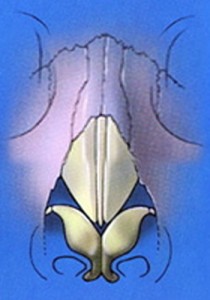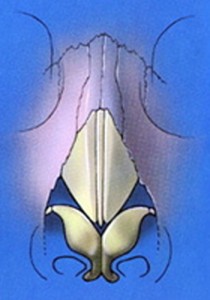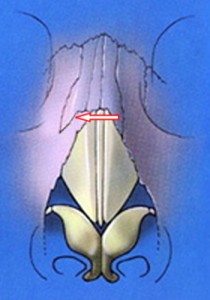Nasal exercises, also known as ‘digital’ exercises, refer to a postoperative instruction that involves massaging the nasal bones after rhinoplasty or revision rhinoplasty surgery. Nasal exercises would only be recommended in rhinoplasty patients where the nasal bones were ‘broken’ during the nose reshaping process. This is also referred to as an osteotomy when the nasal bone is repositioned or narrowed or both. This is commonly performed after a large hump deformity has been corrected and in cases where the nose is crooked. An osteotomy is also frequently done simply to narrow a wide nose during cosmetic rhinoplasty.
Nasal Exercises Explained
Nasal exercises are done to help further contour the nose during the rhinoplasty recovery process. Whenever the nasal bone is reshaped as part of a rhinoplasty surgery, a nasal cast is placed to keep the bones in their new position. The nasal cast is usually removed in 5-6 days. In a majority of cases, the nasal bones are fairly well positioned in their new location. However, because the bones were completely cut and moved, they are also still mobile at 5-6 days out from surgery. Once the cast is removed, the nasal bones have the potential to move or drift out of the desired position. If they do so, they will typically trend toward moving back to their original position. And this movement or drifting can occur any time between cast removal and 6-8 weeks out from surgery. Why 6-8 weeks? Because this is the average amount of time it takes before the nasal bone fuses and heals in its new position.
Nasal Bone Diagram
The adjacent series of diagrams shows this concept visually. For demonstration purposes, we will consider the left photo as having a slightly wide configuration in terms of the nasal bones (light blue shaded area). In the middle you can see how the nasal bones are brought in after osteotomies to become more narrow. Once the cast has been removed, the nasal bones can drift slightly. This can occur on one side only or on both. If they displace, the bone may shift out to the side as indicated by the arrow. Why does the nasal bone do this? Because it is relatively free floating after the osteotomies. Since this area is also susceptible to swelling from the surgery, the bone may drift outward along the with adjacent swollen tissue. While the cast is in place the bone is relatively stable in its position. But once the cast comes off, the soft tissues are free to swell a little and can affect the desired position of the bone. This phenomenon is not the fault of the rhinoplasty surgeon. It is simply something that can and does occur following this type of nose surgery.
Nasal Exercise Technique
It is precisely because of this possibility that I see my rhinoplasty and revision rhinoplasty patients several times in the first few weeks of the recovery process. If I didn’t, the nasal bone might drift out on one or both sides and remain there for several weeks or months before it is discovered to be out of position. If this discovery is made after the bone has now healed (6-8 weeks), there is no recourse but to rebreak the nose. If, however, this is caught within the first 2-3 weeks of the rhinoplasty healing period, nasal exercises can be instituted to help reposition the bone. This window of opportunity (between taking the cast off and 6-8 weeks out) is critical when it comes to starting the nasal exercises.
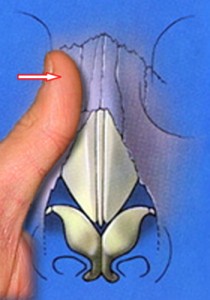 Nasal exercises, as noted above, imply placement of pressure by pushing on the bone to put it back into the desired position. These are also referred to as ‘digital nasal exercises’ since it is normally done with your thumb or finger. I prefer my patients to use the thumb since this has a larger ‘pad’ that can be used to press on the nasal bone. The adjacent diagram shows visually how this is typically done with the thumb. On the patient’s right side of the nose, they would use their right thumb to push on the side of the nose. It is real important that the pressure be applied only to the nasal bone, which is approximately the upper one-third of the nasal bridge. As you can see in the adjacent diagram, the pad of the thumb is used to apply the pressure inward toward the middle of the nose.
Nasal exercises, as noted above, imply placement of pressure by pushing on the bone to put it back into the desired position. These are also referred to as ‘digital nasal exercises’ since it is normally done with your thumb or finger. I prefer my patients to use the thumb since this has a larger ‘pad’ that can be used to press on the nasal bone. The adjacent diagram shows visually how this is typically done with the thumb. On the patient’s right side of the nose, they would use their right thumb to push on the side of the nose. It is real important that the pressure be applied only to the nasal bone, which is approximately the upper one-third of the nasal bridge. As you can see in the adjacent diagram, the pad of the thumb is used to apply the pressure inward toward the middle of the nose.
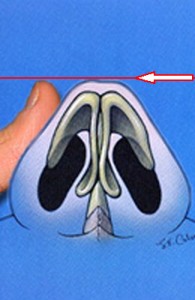 It is also important that you do not push on top of the bridge. In fact, I usually tell my rhinoplasty and revision rhinoplasty patients to make sure the thumb is always below the plane of the bridge. This can be appreciated in the adjacent diagram where the thumb is kept below the red line that indicates the horizontal plane of the nasal dorsum. If the thumb happens to push on top of the bridge it can actually inadvertently push the nasal bones out. Maintaining proper position of the thumb during nasal exercises is obviously critical to achieving the desired rhinoplasty outcome.
It is also important that you do not push on top of the bridge. In fact, I usually tell my rhinoplasty and revision rhinoplasty patients to make sure the thumb is always below the plane of the bridge. This can be appreciated in the adjacent diagram where the thumb is kept below the red line that indicates the horizontal plane of the nasal dorsum. If the thumb happens to push on top of the bridge it can actually inadvertently push the nasal bones out. Maintaining proper position of the thumb during nasal exercises is obviously critical to achieving the desired rhinoplasty outcome.
Normally when pressing on the nasal bones, patients should push down hard enough to elicit some degree of pain. If you don’t, you are not likely effecting any real change in the position of the bone. I normally recommend patients push down to the point of pain, then hold this position steady for approximately one minute. This exercise should be done on average 20-30 times throughout the day. These type of nasal exercises should always be done in conjunction with specific recommendations from your rhinoplasty surgeon. 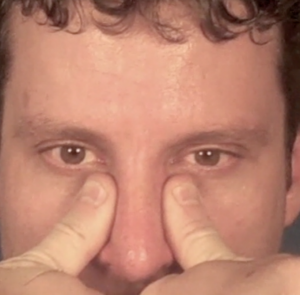 In some rhinoplasty patients, equivalent pressure needs to be applied on both sides to help reposition the nasal bones (as seen in the adjacent photo of one of our San Diego rhinoplasty patients). In others, it might be recommended to do bilateral exercises, but push harder on the left versus right or vice versa. Still in others, the exercises are only necessary on one side to restore the desired symmetry of the nose.
In some rhinoplasty patients, equivalent pressure needs to be applied on both sides to help reposition the nasal bones (as seen in the adjacent photo of one of our San Diego rhinoplasty patients). In others, it might be recommended to do bilateral exercises, but push harder on the left versus right or vice versa. Still in others, the exercises are only necessary on one side to restore the desired symmetry of the nose.
I often times like to see my own San Diego rhinoplasty and revision rhinoplasty patients back every 2-3 weeks to make sure we don’t have to adjust the nasal exercises. Once we get up to 6-8 weeks out from surgery, the nasal exercises can usually be stopped. By this point, the bone has essentially become more fixed in position and is stable enough to resist further movement. This is precisely why it is increasingly difficult to elicit the pain response with nasal exercises as you approach the 6-8 week mark in healing.
Benefits Of Doing Nasal Exercises
The huge benefit of doing nasal exercises following rhinoplasty or revision rhinoplasty is that we can truly optimize the surgical results and achieve the best possible surgical outcome. As I tell my rhinoplasty patients from San Diego all the time – nasal reshaping is a collaborative effort between the facial plastic surgeon and patient. I can do the best possible rhinoplasty while in the operating room, but there are many variables that need to be accounted for following the surgery. Nasal bone drifting following rhinoplasty is a prime example of this. By instituting nasal exercises at the opportune time with proper technique, we can ensure that we are doing everything possible to achieve as much symmetry as possible. Plus, we can maximize chances of getting the nasal bones as narrow as desired following rhinoplasty.

